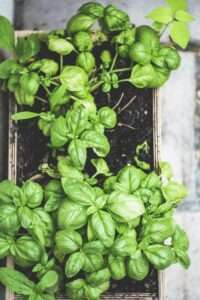 Do you dream of growing your own vegetables but feel limited by available space? You’re not alone: Space is at a premium in many urban and suburban yards, while the desire to eat homegrown, or at least locally grown, produce is thriving. Fortunately, growing fresh vegetables in nooks, crannies and creative containers is completely doable, not to mention fun. Innovative gardeners make use of vertical space and assorted vessels to create beautiful and productive patio gardens.
Do you dream of growing your own vegetables but feel limited by available space? You’re not alone: Space is at a premium in many urban and suburban yards, while the desire to eat homegrown, or at least locally grown, produce is thriving. Fortunately, growing fresh vegetables in nooks, crannies and creative containers is completely doable, not to mention fun. Innovative gardeners make use of vertical space and assorted vessels to create beautiful and productive patio gardens.
Succession planting is a great way to maximize space, as well as sunlight, throughout the growing season. If your planting area receives full sun in spring, think about starting with radishes, beets, kale and salad greens. These cool-season crops enjoy nippy nighttime temperatures and prefer tempered light. Most leafy greens and herbs are just as happy in a pot as in the ground, and some even prefer a little shade.
By the time temperatures warm toward summer, your early-season crops will be ready to give way to heat lovers. Small spaces offer an advantage to warm-season plants. Balconies and patios may be warmer than open swaths of lawn. Brick, stone and siding radiate heat, enabling an earlier start in cooler climates. Summer crops relish warmth to grow, but it also dries them out quickly, especially in pots. Self-watering containers, with a reservoir at the base, come in handy on hot days.
Creative Containers
Plants aren’t picky about pots, as long as they have good drainage. My daughter loves repurposing old rain boots, with holes drilled in the bottom, to grow herbs and greens, which need just six inches of soil to grow.
Grow bags made of thick, porous fabric provide insulation and they are easily stored when not in use. They work well for potatoes, which can be started in early spring. Fill the bags one-third full with soil, and as shoots emerge, cover them with more soil. Continue until the bag is full, then water and wait for a bountiful late-summer harvest.
Window boxes brighten up a façade. Some types attach to balcony and deck railings. Parsley, basil and cilantro are easily accessed from a window box—just snip what you need for your evening meal.
For the ground level, classic half barrels are large enough to hold multiple plants. Elevate all pots using “feet” made of ceramic or bricks, to prevent water from pooling at the base. If you’re lucky enough to have a reclaimed claw-foot tub, well, you’ve got kitsch and functionality all wrapped up!
Fill Pots and Grow On
Fill all planting containers with a mix of two parts potting soil, one part compost and one part peat or vermiculite.
Herbs and “cut and come again” lettuces don’t mind crowding and grow easily from seed. Simply scatter seeds at the top of the soil, and dust about a quarter of an inch of the soil mix on top. Snip greens when they reach four inches, and watch them return for another harvest.
Stocky carrot varieties, such as ‘Nantes’ and ‘Little Finger’, and the rounded cultivar ‘Thumbelina’ grow easily in containers with eight to twelve inches of soil. Thin the seedlings to two inches apart when the greens stand two inches tall.
Like carrots, radishes sprout easily in pots, requiring about two inches of space. Thin the young greens, but don’t throw them in the compost heap: they’re delicious sautéed or in a salad. Round ‘Cherry Belle’ and ‘Watermelon’ or oblong ‘French Breakfast’ reward gardeners with a quick, early harvest.
Sugar snap and shelling peas are perfect spring succession plants. They replenish nitrogen in soil and grow until it’s time for tomatoes. Use a simple bamboo stake for support, or use a tripod trellis in an 18- to 24-inch pot. ‘Tom Thumb’ and ‘Little Marvel’ are dwarf English pea (shelling) varieties. ‘Dwarf Grey Sugar’ is a snap variety that grows well in both spring and fall.
Vining beans, cucumbers, tomatoes, peppers and squash prefer full sun. Save the largest containers for climbers that require a sturdy trellis. Place the trellis or stake in the container when seedlings are small, and add a slow-release, balanced fertilizer. Cucumbers and summer beans grow easily from seeds sown directly in late spring, but tomatoes and peppers are best started earlier indoors. Wait until nighttime temperatures are consistently above 55˚F before moving summer veggies outdoors.
Cucumbers and squash will cover a sturdy trellis leaned against a wall or fence. Both offer numerous bush varieties that do well in pots. Full-size plants may be grown using an overhead canopy trellis, if there’s space. ‘Northern Pickling’ cucumbers have short vines and mature quickly. ‘Picolino’ and ‘Saber’ are sweet slicers that don’t require pollination. Try pattypan or crookneck types for decorative and tasty yellow squash.
Tomato and pepper varieties are as countless as the stars, it seems. Smaller fruit grow best in pots. Cherry tomatoes will drop down from hanging pots, but they prefer to climb. Try ‘Patio Princess’ or the yellow ‘Tumbling Tom’ for abundant harvest. Compact, indeterminate ‘Bush Champion’, ‘Early Girl’ and ‘Celebrity’ produce large fruit quickly, with few pests. Try different varieties and see what works best for both your space and taste buds. Most importantly, have fun, experiment and take time to think about how you’ll use, store and share your bountiful harvest.
BRENDA LYNN www.hortmag.com



